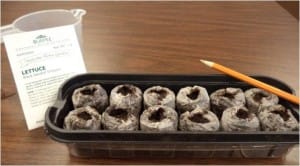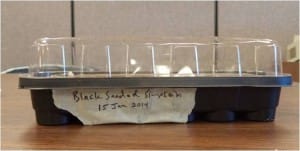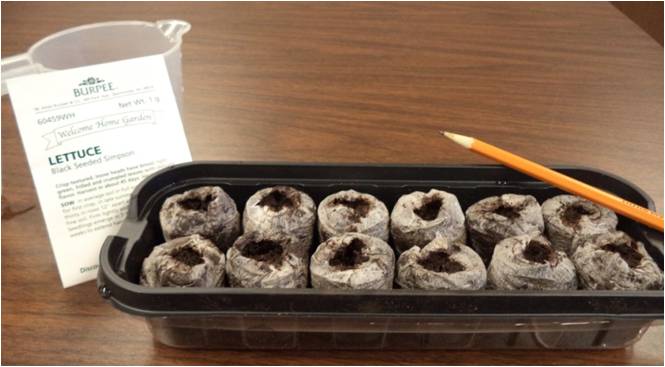I have been asked to re-run this wonderful post from seed starting expert, Amy Whitney, of Cobb Extension. It is time to start your indoor seeds. Amy gives us all the details….
What you’ll need:
- Seeds
- Planting medium
- A container with a clear lid
- Light source
- Time
Which seeds can I start now?
Seeds that are good to start ahead of the usual spring planting typically are those that have a long time-to-maturity, like tomatoes, peppers, and eggplants. Other seeds to start indoors include many kinds of greens.
Will any potting mix work?

Regular potting mix is not the best choice; instead, choose a seedling starter mix. Such a mix will be finely textured, so that small seeds don’t wash too deep down into the mix. Also, it should be sterile (or nearly sterile), so the damping-off fungus that attacks seedlings is less likely to strike. Seedling starter mix can be purchased in small bags to use in your own containers or as flat pellets of either peat moss or coconut coir that inflate as they absorb water.
Why does the container need a lid?

Seeds need to be kept evenly moist but not soggy. If seeds are too wet, they tend to rot rather than germinate, and if they are too dry they won’t germinate, either. The lid helps moderate moisture levels in the container. The lid should be clear to let light in for the growing seedlings. As the seedlings grow taller, the lid will need to be removed.
If the seedlings are in a very sunny window, the “greenhouse” lid may allow too much heat to build up inside the container. Check your seedlings to make sure the young plants don’t end up being cooked under the lid!
Trays and flats especially designed for starting seeds can be purchased at most garden supply stores, but “clamshell” type containers that previously may have held salad greens from a grocery store can also work, after a few holes have been made in the bottom half to allow excess water to drain away.
How much light will my plants need?
After germination has occurred and seedlings have pushed their seed leaves up above the soil level, a strong light source will be needed. A very sunny window is good, but more hours of light would be better. A fluorescent light kept a couple of inches above the tops of the plants for 14-16 hours each day can help provide the needed light.
This sounds easy. When can I start?
You can count back the correct number of weeks for your seeds from the last expected frost date in your area. As an example, a seed that should be started 6-8 weeks before the last frost in an area with an average last frost date of April 10 should be started between February 11th and 25th. Most seed packets include the information about when to start seeds indoors.
Your seed-starting flats or containers will also need to be kept at an adequate temperature range for best germination results. The good news is that the same temperatures that work for most humans, 65-75 degrees F, are also good for seed germination and seedling growth!
As the seedlings mature, they will need to be transferred to more-roomy accommodations (new pots!) with fresh potting mix, to encourage further growth and development.
For additional information and expanded explanations of the above steps, check out UGA’s new guide to seed starting, “Starting Plants from Seed for the Home Gardener” by Horticulturists Sheri Dorn and Bodie Pennisi. UGA’s “Home Garden Transplants,” by UGA Horticulturists Wayne McLauren, Darbie M. Granberry, and W.O. Chance, is another great source of helpful information. Of course, your local UGA Extension Agent is always ready to help!
Amy is a Horticulture Program Assistant for Cobb Extension. She loves seed saving and saves seeds from a heirloom tomato given to her by a guy she met at a seed rack in Home Depot many years ago. Amy will talk plants with anyone! Thanks again Amy. Great information.
Happy planting!
- ParSLAY the Day! - June 12, 2024
- 6th Annual Great Southeast Pollinator Census - May 28, 2024
- Are you ready for Pepper Palooza? - July 5, 2023

Great information! Thanks!
I hope the information helps! Starting seeds at home is a great way to make sure you have the varieties you want, but I’ve found that beginners tend to over-water or use too little light. It can take a couple of tries to find the right balance, but the effort is so worthwhile! Thanks for taking the time to leave a note! –Amy
Great article with good info.
Thanks
Thank you for the kind words! I love this seed-starting time of year and all the trays of little plants that hold the promise of good-food-to-come. — Amy
Very useful article! I’m definitely recommending it to my sister, because she’s just beginning with the seed starting and this all will be of a great help for her. Thank you for sharing all this information! Greets!
Very interesting article and I am very grateful to be useful you have written.You are truly an inspiration for newbies. I really enjoy your content.
Thanks alot for moment
Cheers
Thanks! I am glad you are enjoying the blog!